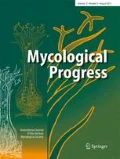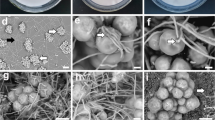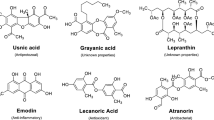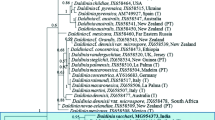Abstract
We report the production of the perylenequinone pigment elsinochrome A in aposymbiotic culture of the mycobiont of the crustose epiphytic lichen Graphis elongata Zenker (Lecanoromycetes), collected in Argentina (Buenos Aires). The substance was not detected in the lichenized thallus (using HPLC techniques) and is otherwise only known from one unrelated lichen and a few genera of non-lichenized, plant-pathogenic fungi in the class Dothideomycetes. The phylogenetic affinities of the lichen mycobiont and the cultured fungus were confirmed using DNA sequence data of the mitochondrial small subunit rDNA (mtSSU), which place the lichen fungus into the Allographa clade within Graphidaceae. The mycobiont pigment was purified and characterized by spectroscopic methods. This is the first case where a rare pigment, otherwise known from non-lichenized, plant-pathogenic fungi, is produced in aposymbiotic culture of a lichen mycobiont, while, at the same time, being absent from the lichen thallus itself. Based on this finding, we discuss the previously postulated hypothesis that lichen mycobionts maintain secondary metabolic pathways of non-lichenized ancestors in their genome, while gene expression and production of metabolites is suppressed in the lichenized state due to toxicity to the photobiont.




Similar content being viewed by others
References
Ahmadjian V (1993) The lichen symbiosis. Wiley, New York
Ahonsi MO, Maurhofer M, Boss D, Défago G (2005) Relationship between aggressiveness of Stagonospora sp. isolates on field and hedge bindweeds, and in vitro production of fungal metabolites cercosporin, elsinochrome A and leptosphaerodione. Eur J Plant Pathol 111:203–215
Ahonsi MO, Boss D, Maurhofer M, Défago G (2006) Potential environmental fate of elsinochrome A, a perylenequinone toxin produced in culture by bindweed biocontrol fungus Stagonospora convolvuli LA39. Environmentalist 26:183–193
Amano T, Miyagawa H, Ueno T, Hamada N (2000) Production of 5, 7-dihydroxy-6-hydroxymethyl-2-methoxy-1, 4-naphthoquinone by the cultured lichen mycobiont of Opegrapha sp. no. 9771836. Z Naturforsch B 55:667–670
Bárcenas Peña A, Lücking R, Miranda-González R, Herrera-Campos MA (2014) Three new species of Graphis (Ascomycota: Ostropales: Graphidaceae) from Mexico, with updates to taxonomic key entries for 41 species described between 2009 and 2013. Lichenologist 46:69–82
Boss D, Maurhofer M, Schläpfer E, Défago G (2007) Elsinochrome A production by the bindweed biocontrol fungus Stagonospora convolvuli LA39 does not pose a risk to the environment or the consumer of treated crops. FEMS Microbiol Ecol 59:194–205
Boustie J, Grube M (2005) Lichens—a promising source of bioactive secondary metabolites. Plant Genet Resour 3:273–287
Brunauer G, Hager A, Grube M, Türk R, Stocker-Wörgötter E (2007) Alterations in secondary metabolism of aposymbiotically grown mycobionts of Xanthoria elegans and cultured resynthesis stages. Plant Physiol Biochem 45:146–151
Cao H, Li C, Liu SX, Shao D, Chen YT, Wang HQ (2000) Structure of elsinochrome A. Acta Chim Sin 58:821–824
Chen CT, Nakanishi K, Natori S (1966) Biosynthesis of elsinochrome A, the perylenequinone from Elsinoë spp. I. Chem Pharm Bull (Tokyo) 14:1434–1437
Chen YK, Li C, Tai H, Chen YT, Gu K, Wang HQ (2003) Photochemistry of amino substituted elsinochrome A: ESR study on the photogeneration of active radical species. Chin J Magn Reson 20:167–172
Chung KR (2011) Elsinoë fawcettii and Elsinoë australis: the fungal pathogens causing citrus scab. Mol Plant Pathol 12:125–135
Culberson CF, Ammann K (1979) Standardmethode zur Dünnschichtchromatographie von Flechtensubstanzen. Herzogia 5:1–24
Culberson CF, Culberson WL (2001) Future directions in lichen chemistry. Bryologist 104:230–234
Daub ME, Chung KR (2009) Photoactivated perylenequinone toxins in plant pathogenesis. In: Deising HB (ed) The mycota, vol 5: plant relationships, 2nd edn. Springer, Berlin Heidelberg, pp 201–219
Daub ME, Herrero S, Chung K-R (2005) Photoactivated perylenequinone toxins in fungal pathogenesis of plants. FEMS Microbiol Lett 252:197–206
Deason TR, Bold HC (1960) Phycological studies I. Exploratory studies of Texas soil algae. University of Texas, Austin. Publication no. 6022
Dong JY, Zhang KQ, Zhao ZX, Liu WZ, Li QY (2001) Nematicidal activity of perylenequinones photosensitive compounds. Mycosystema 20:515–519
Drogies KHE (1997) Isolierung, Strukturaufklärung und Syntheseversuche von biologisch aktiven Sekundärmetaboliten aus endophytischen Mikromyceten. PhD thesis, Universität-Gesamthochschule Paderborn, Germany
Elix JA, Stocker-Wörgötter E (2008) Biochemistry and secondary metabolites. In: Nash TH III (ed) Lichen biology, 2nd edn. Cambridge University Press, Cambridge, pp 104–133
Favilla M, Macchia L, Gallo A, Altomare C (2006) Toxicity assessment of metabolites of fungal biocontrol agents using two different (Artemia salina and Daphnia magna) invertebrate bioassays. Food Chem Toxicol 44:1922–1931
Fazio AT, Adler MT, Bertoni MD, Maier MS (2012) Culture studies on the mycobiont of Caloplaca erythrantha (Tuck.) Zahlbr. (Teloschistaceae): high production of major lichen secondary metabolites. Lichenologist 44:533–542
Frisch A, Kalb K, Grube M (2006) Contributions towards a new systematics of the lichen family Thelotremataceae. Biblioth Lichenol 92:1–556
Gauslaa Y (2009) Ökologische Funktionen von Flechtenstoffen. Rundgespräche der Kommission für Ökologie 36:95–108
Hale ME Jr (1974) Morden-Smithsonian Expedition to Dominica: The lichens (Thelotremataceae). Smithson Contrib Bot 16:1–46
Hale ME Jr (1978) A revision of the lichen family Thelotremataceae in Panama. Smithson Contrib Bot 38:1–60
Hale ME Jr (1981) A revision of the lichen family Thelotremataceae in Sri Lanka. Bull Brit Mus (Nat Hist) Bot Ser 8:227-332
Hall TA (1999) BioEdit: a user-friendly biological sequence alignment editor and analysis program for Windows 95/98/NT. Nucleic Acids Symp Ser 41:95–98
Hamada N (1989) The effect of various culture conditions on depside production by an isolated lichen mycobiont. Bryologist 92:310–313
Hamada N, Tanahashi T, Miyagawa H, Miyawaki H (2001) Characteristics of secondary metabolites from isolated lichen mycobionts. Symbiosis 31:23–33
Huneck S (2001) New results on the chemistry of lichen substances. Prog Chem Org Nat Prod 81:1–276
Huneck S, Yoshimura I (1996) Identification of lichen substances. Springer, Berlin Heidelberg
Izhaki I (2002) Emodin—a secondary metabolite with multiple ecological functions in higher plants. New Phytol 155:205–217
Katoh K, Kuma K, Toh H, Miyata T (2005) MAFFT version 5: improvement in accuracy of multiple sequence alignment. Nucleic Acids Res 33:511–518
Kauff F, Lutzoni F (2002) Phylogeny of the Gyalectales and Ostropales (Ascomycota, fungi): among and within order relationships based on nuclear ribosomal RNA small and large subunits. Mol Phylogenet Evol 25:138–156
Kuyama S, Tamura T (1957) Cercosporin. A pigment of Cercosporina kikuchii Matsumoto et Tomoyasu. I. Cultivation of fungus, isolation and purification of pigment. J Am Chem Soc 79:5725–5726
Lawrey JD (1984) Biology of lichenized fungi. Praeger, New York
Leuckert C, Ahmadjian V, Culberson CF, Johnson A (1990) Xanthones and depsidones of the lichen Lecanora dispersa in nature and of its mycobiont in culture. Mycologia 82:370–378
Li C, He Y, Ou L, Tian M, Yao Z, Guo M (2006) Photophysical and photosensitive properties of Elsinochrome A. Chin Sci Bull 51:1050–1054
Li T, Deng H, Zhao J, Gu Y (2015) Elsinochrome A photosensitizers: alternative drugs for photodynamic therapy. J Innov Opt Health Sci 8:1–10
Liao HL, Chung KR (2008a) Genetic dissection defines the roles of elsinochrome phytotoxin for fungal pathogenesis and conidiation of the citrus pathogen Elsinoë fawcettii. Mol Plant Microbe Interact 21:469–479
Liao HL, Chung KR (2008b) Cellular toxicity of elsinochrome phytotoxins produced by the pathogenic fungus, Elsinoë fawcettii causing citrus scab. New Phytol 117:239–250
Lilly VG, Barnett HL (1951) Physiology of the fungi. McGraw-Hill, New York
Lin SZ, Wei WT, Chen H, Chen KJ, Tong HF, Wang ZH, Ni ZL, Liu HB, Guo HC, Liu DL (2012) Antitumor activity of emodin against pancreatic cancer depends on its dual role: promotion of apoptosis and suppression of angiogenesis. PLoS One 7:e42146
Lousberg RC, Paolillo L, Kon H, Weiss U, Salemink CA (1970) Pigments of Elsinoe species. Part IV. Confirmatory evidence for the structure of elsinochrome A and its ethers from studies of nuclear magnetic resonance (solvent and overhauser effects) and electron spin resonance. J Chem Soc C Organic 16:2154–2159
Lücking R, Chaves JL, Sipman HJM, Umaña L, Aptroot A (2008) A first assessment of the Ticolichen biodiversity inventory in Costa Rica: the genus Graphis, with notes on the genus Hemithecium (Ascomycota: Ostropales: Graphidaceae). Fieldiana Bot 46:1–126
Lücking R, Archer AW, Aptroot A (2009) A world-wide key to the genus Graphis (Ostropales: Graphidaceae). Lichenologist 41:363–452
Lumbsch HT, Kraichak E, Parnmen S, Rivas Plata E, Aptroot A, Cáceres MES, Ertz D, Feuerstein SC, Mercado Díaz JA, Staiger B, Van den Broeck D, Lücking R (2014) New higher taxa in the lichen family Graphidaceae (lichenized Ascomycota: Ostropales) based on a three-gene skeleton phylogeny. Phytotaxa 189:39–51
Ma L, Hong T, Li C, Zhang Y, Wang ZH, Ji WZ (2003) Photodynamic inhibitory effects of three perylenequinones on human colorectal carcinoma cell line and primate embryonic stem cell line. World J Gastroenterol 9:485–490
Ma G, Khan SI, Jacob MR, Tekwani BL, Li Z, Pasco DS, Walker LA, Kahn IA (2004) Antimicrobial and antileishmanial activities of hypocrellins A and B. Antimicrob Agents Chemother 48:4450–4452
Mangold A, Martín MP, Lücking R, Lumbsch HT (2008) Molecular phylogeny suggests synonymy of Thelotremataceae within Graphidaceae (Ascomycota: Ostropales). Taxon 57:476–486
Mason-Gamer RJ, Kellogg EA (1996) Testing for phylogenetic conflict among molecular data sets in the tribe Triticeae (Gramineae). Syst Biol 45:524–545
Mathey A (1986) De in situ lichenum investigatione. PhD thesis, University Pierre and Marie Curie, Paris
Mathey A, Lukins PB (2001) Spatial distribution of perylenequinones in lichens and extended quinones in quincyte using confocal fluorescence microscopy. Micron 32:107–113
Mathey A, Van Roy W, Van Vaeck L, Eckhardt G, Steglich W (1994) In situ analysis of a new perylene quinone in lichens by Fourier-transform laser microprobe mass spectrometry with external source. Rapid Commun Mass Spectrom 8:46–52
Mebius HJ, Krabbendam H, Duisenberg AJM (1990) Structure of elsinochrome A. Acta Crystallogr C 46:267-271
Meille SV, Malpezzi L, Allegra G, Nasini G, Weiss U (1989) Structure of elsinochrome A: a perylenequinone metabolite. Acta Crystallogr C 45:628–632
Mercado-Díaz JA, Gould WA, González G, Lücking R (2015) Lichens in Puerto Rico: an ecosystem approach. International Institute of Tropical Forestry. General Technical Report IITF-GTR-46, 76 pp
Miadlikowska J, Lutzoni F (2000) Phylogenetic revision of the genus Peltigera (lichen-forming Ascomycota) based on morphological, chemical, and large subunit nuclear ribosomal DNA data. Int J Plant Sci 161:925–958
Miller MA, Pfeiffer W, Schwartz T (2010) Creating the CIPRES Science Gateway for inference of large phylogenetic trees. In: Proceedings of the Gateway Computing Environments Workshop (GCE), New Orleans, Louisiana, November 2010, pp 1–8
Miyagawa H, Hamada N, Sato M, Eeno T (1994) Pigments from the cultured lichen mycobionts of Graphis scripta and G. desquamescens. Phytochemistry 36:1319–1322
Moncada B, Lücking R (2012) Ten new species of Sticta and counting: Colombia as a hot spot for unrecognized diversification in a conspicuous macrolichen genus. Phytotaxa 74:1–29
Muggia L, Schmitt I, Grube M (2009) Lichens as treasure chests of natural products. Sim News 59:85–97
Müller K (2001) Pharmaceutically relevant metabolites from lichens. Appl Microbiol Biotechnol 56:9–16
Nelsen MP, Rivas Plata E, Andrew CJ, Lücking R, Lumbsch HT (2011) Phylogenetic diversity of trentepohlialean algae associated with lichen-forming fungi. J Phycol 47:282–290
Nimis PL, Skert N (2006) Lichen chemistry and selective grazing by the coleopteran Lasioderma serricorne. Environ Exp Bot 55:175–182
Niu DL, Wang LS, Zhang YJ, Yang CR (2007) Secondary metabolites and bioactivities of lichens. Nat Prod Res Dev 19:1079–1086
Orange A, James PW, White FJ (2001) Microchemical methods for the identification of lichens. British Lichen Society Bulletin. British Lichen Society, London
Penn O, Privman E, Ashkenazy H, Landan G, Graur D, Pupko T (2010a) GUIDANCE: a web server for assessing alignment confidence scores. Nucleic Acids Res 38:W23–W28
Penn O, Privman E, Landan G, Graur D, Pupko T (2010b) An alignment confidence score capturing robustness to guide tree uncertainty. Mol Biol Evol 27:1759–1767
Ranković B (2015) Lichen secondary metabolites: bioactive properties and pharmaceutical potential. Springer International Publishing, Cham, Switzerland
Rivas Plata E, Hernández M, Jesús E, Lücking R, Staiger B, Kalb K, Cáceres MES (2011) Graphis is two genera: a remarkable case of parallel evolution in lichenized Ascomycota. Taxon 60:99–107
Rivas Plata E, Lücking R, Lumbsch HT (2012) A new classification for the family Graphidaceae (Ascomycota: Lecanoromycetes: Ostropales). Fungal Divers 52:107–121
Skrobek A, Boss D, Défago G, Butt TM, Maurhofer M (2006) Evaluation of different biological test systems to assess the toxicity of metabolites from fungal biocontrol agents. Toxicol Lett 161:43–52
Staiger B (2002) Die Flechtenfamilie Graphidaceae. Studien in Richtung einer natürlicheren Gliederung. Bibl Lichenol 85:1–526
Stamatakis A (2006) RAxML-VI-HPC: maximum likelihood-based phylogenetic analyses with thousands of taxa and mixed models. Bioinformatics 22:2688–2690
Stamatakis A, Ludwig T, Meier H (2005) RAxML-III: a fast program for maximum likelihood-based inference of large phylogenetic trees. Bioinformatics 21:456–463
Stergiopoulos I, Collemare J, Mehrabi R, De Wit PJGM (2013) Phytotoxic secondary metabolites and peptides produced by plant pathogenic Dothideomycete fungi. FEMS Microbiol Rev 37:67–93
Stocker-Wörgötter E (2008) Metabolic diversity of lichen-forming ascomycetous fungi: culturing, polyketide and shikimate metabolite production, and PKS genes. Nat Prod Rep 25:188–200
Stocker-Wörgötter E, Cordeiro LMC, Iacomini M (2013) Accumulation of potential pharmaceutically relevant lichen metabolites in lichens and cultured lichen symbionts. In: Atta-ur-Rahman (ed) Studies in natural products chemistry. Elsevier, New York, pp 337–380
Studzińska E, Witkowska-Banaszczak E, Bylka W (2008) Bioactive compounds of lichen. Herba Pol 54:79–88
Takahashi K, Kinoshita K, Yamamoto Y, Koyama K, Yoshimura I (2005) Chemical constituents from lichens for pharmaceutical and industrial uses. Folia Cryptogam Est 41:109–114
Takenaka Y, Morimoto N, Hamada N, Tanahashi T (2011) Phenolic compounds from the cultured mycobionts of Graphis proserpens. Phytochemistry 72:1431–1435
Towers GHN, Page JE, Hudson JB (1997) Light-mediated biological activities of natural products from plants and fungi. Curr Org Chem 1:395–414
Varol M, Tay T, Candan M, Türk A, Koparal AT (2015) Evaluation of the sunscreen lichen substances usnic acid and atranorin. Biocell 39:25–31
Vilgalys R, Hester M (1990) Rapid genetic identification and mapping of enzymatically amplified ribosomal DNA from several Cryptococcus species. J Bacteriol 172:4238–4246
Wang LF, Zhang HY (2005) A theoretical study on physicochemical properties of elsinochrome A in ground state. J Mol Struct Teochem 726:135–140
Weiss U, Flon H, Burger WC (1957) The photodynamic pigment of some species of Elsinoë and Sphaceloma. Arch Biochem Biophys 69:311–319
Weiss U, Ziffer H, Batterham TJ, Blumer M, Hackeng WHL, Copier H, Salemink CA (1965) Pigments of Elsinoë species. I. Pigment production by Elsinoë species; isolation of pure elsinochromes A, B, and C. Can J Microbiol 11:57–66
Weiss U, Merlini L, Nasini G (1987) Naturally occurring perylenequinones. Fortschr Chem Org Naturst 52:1–71
Wirth M, Hale ME (1963) The lichen family Graphidaceae in Mexico. Contributions from the U. S. National Herbarium 36:63–118
Wirth M, Hale ME (1978) Morden-Smithsonian Expedition to Dominica: the lichens (Graphidaceae). Smithson Contrib Bot 40:1-64
Xing M, Zhang X, Sun Z, Zhang H (2003) Perylenequinones act as broad-spectrum fungicides by generating reactive oxygen species both in the dark and in the light. J Agric Food Chem 51:7722–7724
Yamamoto Y (2000) Biological activity of lichens and lichen substances. Lichen - News Bull Lichenological Soc Jpn 12:7–11
Zhang J, He H, Ljiang J, Wang Y, Wu X (2006) Study on the photosensitive bioactivity of elsinochrome A. J Huaihua Univ 2:68–69
Zhang Y, Xie J, Zhang L, Li C, Chen H, Gu Y, Zhao J (2009) A novel elsinochrome A derivative: a study of drug delivery and photodynamic activity. Photochem Photobiol Sci 8:1676–1682
Zoller S, Scheidegger C, Sperisen C (1999) PCR primers for the amplification of mitochondrial small subunit ribosomal DNA of lichen-forming ascomycetes. Lichenologist 31:511–516
Acknowledgements
The authors thank the National Research Council of Argentina (CONICET) and the University of Buenos Aires for the financial support. A.T. Fazio, M.T. Adler, and M.S. Maier are Research Members of CONICET. The workshop where the lichen was first studied, as well as the molecular work, were supported by grants from the National Science Foundation: Neotropical Epiphytic Microlichens—An Innovative Inventory of a Highly Diverse yet Little Known Group of Symbiotic Organisms (DEB-0715660 to The Field Museum; PI R. Lücking) and ATM—Assembling a taxonomic monograph: The lichen family Graphidaceae (DEB-1025861 to The Field Museum; PI T. Lumbsch, CoPI R. Lücking).
Author information
Authors and Affiliations
Corresponding author
Additional information
Section Editor: Gerhard Rambold
Rights and permissions
About this article
Cite this article
Fazio, A.T., Adler, M.T., Parnmen, S. et al. Production of the bioactive pigment elsinochrome A by a cultured mycobiont strain of the lichen Graphis elongata. Mycol Progress 17, 479–487 (2018). https://doi.org/10.1007/s11557-017-1374-1
Received:
Revised:
Accepted:
Published:
Issue Date:
DOI: https://doi.org/10.1007/s11557-017-1374-1




